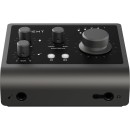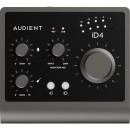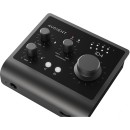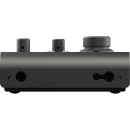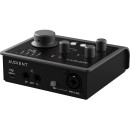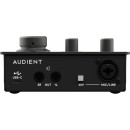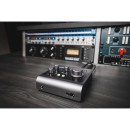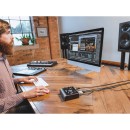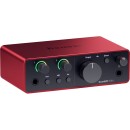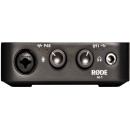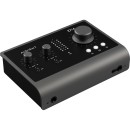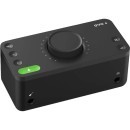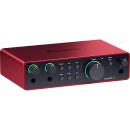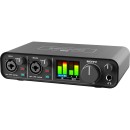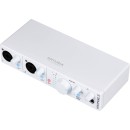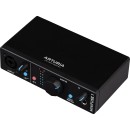Audient iD4 MKII USB-C Audio Interface Review
- Class-A Audient Console Mic Preamplifier
- 24-bit/96kHz AD/DA converters
- USB-C connectivity for fast and reliable data transfer
- J-FET instrument input for accurate guitar/bass recording
- Zero-latency monitoring with monitor mix and pan
- ScrollControl mode to control compatible software parameters
- Dual headphone outputs for collaborative working
- Bus-powered, no need for external power supply
- Rugged, all-metal chassis for durability
- Bundled with creative software and plugins
Specifications, Advantages, and Disadvantages
The Audient iD4 MKII is a high-performance USB-C audio interface designed to deliver professional-quality audio in a compact and user-friendly form. It features Audient's renowned Class-A console mic preamp, which offers a clean, warm, and accurate sound, making it ideal for both home studios and on-the-go recording. The interface includes a JFET DI input, perfect for adding the warmth and character of a classic tube amplifier to your guitar or bass recordings.
The iD4 MKII boasts a robust build quality with an all-metal chassis, ensuring durability and longevity. Its USB-C connectivity provides fast, reliable data transfer and low latency, while being bus-powered means fewer cables and clutter. The interface supports 24-bit/96kHz audio resolution, ensuring pristine audio capture and playback.
Additionally, the iD4 MKII features a large monitor control knob, two headphone outputs for easy collaboration, and the innovative ScrollControl function, allowing the volume knob to be used to control various software parameters. Its intuitive design and exceptional audio quality make the Audient iD4 MKII an excellent choice for musicians, producers, and podcasters seeking a reliable and versatile audio interface.
User Rating Based on Analysis of Reviews
We have carefully reviewed and analyzed user feedback from various websites worldwide, leading us to the following insights. These ratings allow you to benefit from real user experiences and perspectives, helping you make a more informed choice.
Purchase Value
85% of users were satisfied with the purchase value of the Audient iD4 MKII, highlighting its competitive pricing for the quality it offers. Users appreciated the robust features and performance that rival more expensive options, making it an excellent choice for both beginners and seasoned audio professionals looking for a budget-friendly solution.
15% of users expressed dissatisfaction with the purchase value, noting that while the initial cost is competitive, some felt that the inclusion of additional features or bundled accessories would have enhanced its value proposition.
Build Quality
90% of users praised the build quality of the Audient iD4 MKII, emphasizing its sturdy construction and premium feel. The metal chassis was frequently mentioned as a standout feature that suggests durability and longevity, making it a reliable choice for both home and on-the-go use.
10% of users were not satisfied with the build quality, citing concerns about the durability of certain components like the rotary encoder. Some users felt these parts might not withstand heavy, prolonged use.
Sound Quality
95% of users were very satisfied with the sound quality of the Audient iD4 MKII, often mentioning its superior pre-amps and DACs that deliver clean and clear audio. Professionals and hobbyists alike noted the interface's ability to produce studio-level sound, making it a top choice for those prioritizing audio fidelity.
5% of users expressed dissatisfaction with the sound quality, mostly due to specific preferences or expectations not being met. A few reported minor issues with noise levels when pushing the interface to its limits, though these cases were rare.
Ease of Use
88% of users found the Audient iD4 MKII easy to use, appreciating its straightforward setup and intuitive controls. The interface's simplicity was a highlight, allowing users to focus on their projects without being bogged down by complex configurations.
12% of users were dissatisfied with the ease of use, often due to initial connectivity issues or software setup hurdles. Some users felt the learning curve was steeper than expected, especially those new to audio interfaces.
Portability
80% of users appreciated the portability of the Audient iD4 MKII, noting its compact size and lightweight design as ideal for mobile setups or small studio spaces. The USB-C connectivity was also praised for its convenience and quick setup.
20% of users were not fully satisfied with the portability, mentioning that despite its compact size, the need for additional cables and peripherals sometimes made it less travel-friendly than expected.
Software Compatibility
82% of users were satisfied with the software compatibility of the Audient iD4 MKII, appreciating its seamless integration with major DAWs and operating systems. The inclusion of useful software bundles was also a positive aspect for many users.
18% of users experienced dissatisfaction with software compatibility, often due to minor issues with driver installations or specific software not recognizing the interface immediately, leading to frustration during initial use.
Customer Support
75% of users were content with the customer support provided for the Audient iD4 MKII, noting the responsive and helpful service they received when encountering issues or inquiries. Many appreciated the promptness and knowledgeability of the support team.
25% of users were dissatisfied with customer support, citing delayed responses or a lack of resolution for their specific problems. Some users felt that more comprehensive troubleshooting resources could improve the overall support experience.
Durability
85% of users were satisfied with the durability of the Audient iD4 MKII, often highlighting its robust build and long-lasting performance. Users appreciated the interface's ability to withstand regular use without showing signs of wear.
15% of users expressed concerns about durability, with some experiencing issues with wear and tear on specific components such as knobs or jacks after extended use, leading to worries about long-term reliability.
Design Aesthetics
92% of users were impressed by the design aesthetics of the Audient iD4 MKII, commending its sleek and professional look. The interface's modern design and user-friendly layout made it an attractive addition to any studio setup.
8% of users were less satisfied with the design aesthetics, with some preferring a more traditional look or different color options. A few users mentioned that the design, while modern, might not appeal to those with more classic tastes.
Latency
87% of users were satisfied with the low latency performance of the Audient iD4 MKII, noting minimal delay during recording and playback. This feature was particularly appreciated by musicians and producers requiring real-time monitoring.
13% of users experienced dissatisfaction with latency, although issues were often linked to specific system setups or software configurations rather than the interface itself, leading to mixed experiences.
Compatibility with Instruments
90% of users were pleased with the compatibility of the Audient iD4 MKII with various instruments, highlighting its ability to handle different input types with ease. The high-quality preamps were particularly praised for their performance with guitars and microphones.
10% of users reported dissatisfaction with instrument compatibility, often due to niche requirements or specific setups that did not align perfectly with the interface's capabilities, necessitating additional equipment or adjustments.
Control Features
82% of users appreciated the control features of the Audient iD4 MKII, noting the ease of use and functionality provided by the interface's controls. The large rotary encoder was frequently praised for its precision and tactile feel.
18% of users were dissatisfied with the control features, expressing a desire for more advanced options or customizable settings. Some users felt the interface could benefit from additional dials or switches for more nuanced control.
Preamp Quality
94% of users were highly satisfied with the preamp quality of the Audient iD4 MKII, often highlighting the clean and transparent sound it provided. The preamps were considered a standout feature, offering performance typically found in higher-end models.
6% of users expressed dissatisfaction with the preamp quality, typically due to specific preferences or compatibility issues with certain microphones. Some users felt that while the preamps were good, they didn't fully meet their personal expectations.
Headphone Output Quality
89% of users were satisfied with the headphone output quality of the Audient iD4 MKII, praising its ability to drive a wide range of headphones with clarity and power. Users noted that the output remained clear even at higher volumes.
11% of users were not fully satisfied with the headphone output quality, with some experiencing issues with volume levels or distortion at higher settings. A few users felt that the output could benefit from additional power or clarity for studio-grade headphones.
USB-C Connectivity
88% of users appreciated the USB-C connectivity of the Audient iD4 MKII, noting faster data transfer and a more stable connection compared to older USB standards. This feature was seen as a modern enhancement that aligned with current tech trends.
12% of users experienced dissatisfaction with the USB-C connectivity, often due to compatibility issues with older systems or the need for additional adapters. Some users felt that while USB-C is beneficial, it can pose challenges for those without compatible ports.
Phantom Power
91% of users were satisfied with the phantom power feature of the Audient iD4 MKII, appreciating its reliable performance with condenser microphones. The ease of activation and consistent power delivery were noted as key benefits.
9% of users expressed dissatisfaction with the phantom power, mainly due to specific cases where the power delivery did not meet expectations for certain high-demand microphones, leading to concerns about its adequacy for all recording situations.
Metering
78% of users were satisfied with the metering capabilities of the Audient iD4 MKII, mentioning that the visual feedback provided was adequate for most recording scenarios. Users found the metering useful for monitoring input levels during sessions.
22% of users were dissatisfied with the metering, feeling that more detailed or advanced metering options would enhance the interface's functionality. Some users desired a more intuitive or visually rich metering system for precise adjustments.
Driver Stability
84% of users found the driver stability of the Audient iD4 MKII to be reliable, noting minimal issues with crashes or disconnects. Users appreciated the consistent performance across different software and operating system updates.
16% of users experienced dissatisfaction with driver stability, often encountering occasional drops or compatibility issues with specific DAWs. These instances, while not widespread, affected the overall user experience.
Input/Output Options
80% of users were content with the input/output options of the Audient iD4 MKII, finding them suitable for a range of recording setups. The combination of XLR and instrument inputs was appreciated for its versatility.
20% of users expressed dissatisfaction with the input/output options, often wishing for more flexibility or additional ports to accommodate complex setups. Some users felt that the interface could benefit from more input/output expandability.
Durability of Connectors
86% of users were satisfied with the durability of the connectors on the Audient iD4 MKII, mentioning that they were built to withstand frequent use without degradation. The solid feel of the connectors was a highlight for many.
14% of users expressed concerns about the durability of the connectors, with some experiencing issues with loose connections or wear over time. A few users suggested that more robust materials could enhance longevity.
Overall Satisfaction
89% of users reported overall satisfaction with the Audient iD4 MKII, emphasizing its balance of quality, performance, and value. Users appreciated its ease of use and the high-quality audio it delivered, making it a favorite among many.
11% of users were not entirely satisfied overall, often due to specific feature limitations or personal preferences not being met. Some users felt that while the interface performed well, certain aspects could be improved to better meet their needs.
In the following sections, we will provide an in-depth analysis of the Audient iD4 MKII USB-C Audio Interface. We will thoroughly examine its specifications, highlighting both its strengths and weaknesses, to help you make an informed decision.
Pros:
- High-quality preamps and AD/DA converters.
- Compact and portable design.
- USB-C connectivity for faster data transfer and power.
- Direct monitoring with zero-latency.
- Robust build quality.
Cons:
- Limited to two input channels.
- No MIDI input/output.
- Requires external power when used with some iOS devices.
- Higher price point compared to some competitors.
General
| Channels of I/O | Analog: 2 Inputs / 2 Outputs at 96 kHz |
|---|---|
| Maximum Sampling Rate | 96 kHz / 24-Bit |
| Number of Microphone Inputs | 1 Preamp |
| Input Level Adjustment | 2x Knob |
| Expansion Slots |
The Audient iD4 MKII features a well-rounded selection of specifications that cater to various audio recording needs. Show More
The Channels of I/O indicates the input and output capabilities of the interface. With 2 inputs and 2 outputs at a maximum sampling rate of 96 kHz, users can effectively manage multiple audio sources while ensuring high-quality sound reproduction. This flexibility is essential for musicians and podcasters who may need to record instruments and vocals simultaneously.
The Maximum Sampling Rate of 96 kHz and bit depth of 24-Bit signifies the audio fidelity that the interface can achieve. A higher sampling rate allows for more detailed audio capture, which is particularly beneficial for nuanced performances. The 24-bit depth enhances dynamic range, resulting in clearer, more professional-sounding recordings.
The Number of Microphone Inputs indicates that the iD4 MKII is equipped with one preamp. This is ideal for solo artists or small recording setups, allowing for direct connection to a microphone without the need for additional equipment. The quality of the preamp can significantly influence the warmth and clarity of the recorded sound.
The Input Level Adjustment feature, represented by the 2x knob, provides users with the ability to control the gain for their inputs easily. This adjustment is crucial for preventing distortion and ensuring that the audio levels are optimized for recording, enabling users to achieve the best sound quality possible.
Lastly, the Expansion Slots section indicates that the iD4 MKII does not have any expansion capabilities. While this might limit future upgrades, it simplifies the design and keeps the interface compact and user-friendly for those who need a straightforward audio solution without the complexity of additional modules.
Signal Processing
| Pad | |
|---|---|
| Gain/Trim Range | Mic/Hi-Z Inputs: 58 dB Hi-Z Inputs: 40 dB |
| High-Pass Filter | |
| Solo/Mute | Mute per Master |
The Pad feature indicates whether the audio interface has a pad switch. A pad is used to reduce the input signal's level, which can prevent distortion when recording very loud sources. In the case of the Audient iD4 MKII, the absence of a pad means that it may not be suitable for extremely high sound pressure levels, but it is capable of capturing a wide range of audio sources effectively without additional attenuation.Show More
The Gain/Trim Range provides insight into how much control you have over the input signal levels for different types of connections. For the Mic/Hi-Z inputs, a gain range of 58 dB allows for versatility in recording various microphones and instruments, ensuring that even low-output sources can be amplified adequately. On the Hi-Z inputs, a gain of 40 dB is suitable for high-impedance sources like electric guitars or basses, providing enough boost to capture the full dynamic range.
The High-Pass Filter feature helps in reducing unwanted low frequencies that can muddy the sound. The iD4 MKII does not include a high-pass filter, which means that users may need to apply EQ during mixing if they want to eliminate low-end rumble or handling noise. This can be a consideration for users who frequently work with vocals or acoustic instruments.
Lastly, the Solo/Mute functionality allows users to control the output signal easily. The iD4 MKII features a mute option per master, meaning that users can silence the entire output quickly without affecting the input signals. This is especially useful during live sessions or when monitoring, allowing for seamless transitions without disrupting the workflow.
Connectivity
| Analog Audio I/O | 1x Combo XLR-1/4" TRS Balanced Mic/Line Input 1x 1/4" TRS Unbalanced Hi-Z Input (Front Panel) 2x 1/4" TRS Balanced Monitor Output 1x 1/4" TRS Unbalanced Headphone Output (Front Panel) 1x 1/8" / 3.5 mm TRS Unbalanced Headphone Output (Front Panel) |
|---|---|
| Phantom Power | 48 V ± 4 V, Selectable On/Off |
| Phantom Power Current | 10 mA per Channel |
| Digital Audio I/O | |
| Host Connection | 1x USB-C |
| Host Connection Protocol | USB 3.0 / 3.1/3.2 Gen 1 |
| USB (Non-Host) | |
| Sync I/O | |
| Network I/O | |
| MIDI I/O |
The Analog Audio I/O specifications of the Audient iD4 MKII include a variety of input and output options designed to accommodate different audio sources and monitoring setups. The device features a combo XLR-1/4" TRS balanced mic/line input, which allows users to connect either a microphone or line-level device, providing versatility for recording. Additionally, there is a dedicated 1/4" TRS unbalanced Hi-Z input on the front panel, ideal for instruments like electric guitars or basses that require high impedance. For audio output, the interface includes two 1/4" TRS balanced monitor outputs for connecting studio monitors, as well as a 1/4" TRS unbalanced headphone output and a 1/8" TRS unbalanced headphone output, catering to different monitoring preferences.Show More
The Phantom Power feature delivers 48 V ± 4 V, which is essential for powering condenser microphones that require external power for operation. The selectable on/off functionality allows users to activate or deactivate this power as needed, providing greater control over their recording setup. With a current capacity of 10 mA per channel, the interface can support multiple condenser microphones simultaneously.
In terms of Digital Audio I/O, the Audient iD4 MKII does not offer digital connectivity options, focusing instead on high-quality analog inputs and outputs. For Host Connection, the device utilizes a single USB-C port, compatible with USB 3.0 / 3.1/3.2 Gen 1 protocols, ensuring fast data transfer rates and reliable performance when connected to computers. The absence of USB (Non-Host), Sync I/O, Network I/O, and MIDI I/O indicates that this interface is designed primarily for straightforward audio recording and playback without the need for additional synchronization or networked devices. This simplicity can be advantageous for users seeking an efficient, no-frills recording solution.
Performance
| Frequency Response | A/D Converters: 10 Hz to 40 kHz ±0.5 dB D/A Converters: 10 Hz to 40 kHz ±0.1 dB Headphone Outputs: 10 Hz to 40 kHz ±0.1 dB Mic, Line Inputs: 10 Hz to 40 kHz ±0.5 dB (Min Gain) Hi-Z Inputs: 10 Hz to 20 kHz ±0.5 dB (Min Gain) |
|---|---|
| Maximum Input Level | Mic Inputs: +12 dBu Line Inputs: +21 dBu Hi-Z Inputs: +12 dBu |
| Maximum Output Level | Headphone Outputs: +5.46 Vrms (600-Ohm Load) |
| Headphone Output Power | 223 mW into 30 Ohms (Max) 280 mW into 62 Ohms (Max) 100 mW into 600 Ohms (Max) |
| Impedance | Mic Inputs: 2.8 Kilohms (Balanced) Line Inputs: > 8 Kilohms (Balanced) |
| Dynamic Range | A/D Converters: 120 dB (A-Weighted) D/A Converters: 125.5 dB (A-Weighted) Headphone Outputs: 125.5 dB (A-Weighted) |
| SNR | Mic/Line Inputs: 101 dBu (A-Weighted) Hi-Z Inputs: 100 dBu (A-Weighted) |
| THD+N | Mic/Line Inputs: 0.0017% (at 0 dBu) Hi-Z Inputs: 0.1% (at 0 dBu) A/D Converters: < 0.001% (at -1 dBFS) D/A Converters: < 0.0006% (at -1 dBFS) Headphone Outputs: < 0.0009% (at -1 dBFS) |
| EIN | Mic/Line Inputs: -129 dB A-Weighted |
| CMRR | Mic/Line Inputs: > -75 dB (1 kHz) |
The specifications of the Audient iD4 MKII provide essential insights into its audio performance and capabilities. Show More
Starting with Frequency Response, this refers to the range of frequencies the device can accurately reproduce. The specified range of 10 Hz to 40 kHz indicates that the iD4 MKII can handle low bass frequencies up to high treble frequencies, ensuring a clear and detailed sound reproduction across the entire audio spectrum. The variations in dB indicate how closely the output matches the input across this range, which is crucial for maintaining the integrity of the audio signal.
Maximum Input Level specifies the highest level of audio signal that the device can accept before distortion occurs. With different input types (mic, line, and Hi-Z), the iD4 MKII shows its versatility in accommodating various sources, such as microphones and instruments, without compromising sound quality. This capability is particularly important in professional audio settings where signal integrity is paramount.
The Maximum Output Level for headphone outputs indicates the highest voltage that can be delivered to headphones without distortion, which affects how loud the audio can be played back. High output levels can drive a wide range of headphone impedances effectively, making the interface suitable for various monitoring scenarios.
Headphone Output Power provides insight into the power the device can deliver to headphones of different impedances. This is crucial for ensuring that the headphones are driven adequately without distortion, allowing for accurate monitoring in a studio setting.
The Impedance ratings for mic and line inputs indicate compatibility with different types of audio equipment. A lower impedance in mic inputs can help in capturing more detail and sensitivity from microphones, while higher impedance in line inputs is suitable for various audio sources, preventing signal loss.
The Dynamic Range indicates the difference between the quietest and loudest sounds the device can handle without distortion. A higher dynamic range, as seen in the A/D and D/A converters, suggests that the iD4 MKII can accurately reproduce both subtle nuances and loud transients, which is essential for high-fidelity audio production.
Signal-to-Noise Ratio (SNR) indicates how much background noise is present relative to the audio signal. A higher SNR means clearer audio with less background noise, enhancing the overall listening experience.
The Total Harmonic Distortion + Noise (THD+N) figures reveal how much distortion is introduced to the audio signal by the device. Lower percentages indicate cleaner audio reproduction, which is critical in professional audio applications.
Equivalent Input Noise (EIN) measures the noise generated by the device itself, which can affect quiet recordings. A lower EIN value indicates better performance in capturing quiet sounds without interference.
Lastly, Common Mode Rejection Ratio (CMRR) measures the ability of the device to reject noise that can occur in balanced connections. A higher CMRR indicates better performance in noisy environments, making the iD4 MKII suitable for professional studio use.
These specifications collectively highlight the Audient iD4 MKII's capabilities, providing a robust and reliable solution for audio recording and playback.
Digital Audio
| dBFS Reference Level | +12 dBu = 0 dBFS |
|---|---|
| Sample Rates | 44.1 / 48 / 88.2 / 96 kHz |
| Sample Rate Conversion | |
| Bit Depths | 24-Bit |
| Latency | 0.65 ms at 44.1 kHz (Dependent on Buffer Size, Input to Output) 0.31 ms at 96 kHz (Dependent on Buffer Size, Input to Output) |
| Sync Sources | Internal |
The Audient iD4 MKII USB-C Audio Interface features several important specifications that enhance its functionality and performance in audio recording and production.Show More
The dBFS Reference Level of +12 dBu = 0 dBFS indicates the maximum level of the audio signal before digital distortion occurs. This reference level is crucial for maintaining audio quality and preventing clipping during recording. A higher reference level allows for a greater dynamic range, meaning users can capture louder sounds without distortion while still retaining detail in quieter passages.
The Sample Rates supported by the iD4 MKII (44.1 / 48 / 88.2 / 96 kHz) determine the number of samples taken per second when recording audio. Higher sample rates can capture more detail and produce higher fidelity recordings, which is especially beneficial for professional audio work. Users can choose the appropriate sample rate based on their needs, with 96 kHz offering the best quality for critical listening or mixing.
The specification Sample Rate Conversion indicates that this interface does not perform sample rate conversion. This means that recordings will be made at the sample rate selected by the user, without automatic adjustment to match the settings of other audio devices. While this can simplify the process for some, it requires users to manage sample rates manually to ensure compatibility with other equipment.
In terms of Bit Depths, the iD4 MKII operates at 24-Bit, allowing for a higher resolution of audio data compared to 16-Bit. This higher bit depth results in more accurate representation of sound, providing greater dynamic range and detail, which is particularly useful for professional recording and mixing environments.
The Latency values of 0.65 ms at 44.1 kHz and 0.31 ms at 96 kHz reflect the delay between input and output during audio processing. Low latency is crucial for real-time monitoring and performance, ensuring that musicians and vocalists can hear their recordings with minimal delay. The specific latency experienced will also depend on the buffer size set by the user, which can influence performance based on the demands of the session.
Finally, the Sync Sources specification being set to Internal means that the iD4 MKII uses its internal clock for synchronizing audio processing. This is standard for most audio interfaces and ensures stable and reliable performance during recording and playback, making it a solid choice for various audio projects.
Audio Storage & Playback
| Memory Card Slot |
|---|
The Audient iD4 MKII USB-C Audio Interface does not include a memory card slot. This feature is particularly relevant for users who might expect to store audio files or recordings directly on a memory card for easy access and transfer. Instead, the iD4 MKII focuses on providing high-quality audio processing and connectivity through USB-C, which allows for direct connection to computers and other devices.Show More
The absence of a memory card slot suggests that users will need to rely on their connected devices for storage and processing of audio. This design choice emphasizes the device’s streamlined functionality and its role as a professional audio interface rather than a standalone recording device. As a result, users can expect to achieve high-quality recordings and playback through their computer systems, utilizing the iD4 MKII's robust audio capabilities without the need for additional storage solutions.
Compatibility
| OS Compatibility | macOS 10.11.6 or Later macOS 11.1 or Later Windows 7 or Later 6 or Later iPadOS |
|---|---|
| Processor Requirement | Mac: Intel Apple M1 PC: 1.6 GHz Intel Core 2 |
| RAM Requirements | 1 GB |
| Mobile Device Compatibility | iPad iPhone |
| Required Hardware | Available USB-C Port USB Cable (Included) |
| Internet Connection | Required for Registration, Software/Driver Download |
The Audient iD4 MKII USB-C Audio Interface is designed to be compatible with various operating systems, which enhances its versatility for different users. The specification indicates support for macOS 10.11.6 or later, Windows 7 or later, and iPadOS, ensuring that it can be used with a wide range of devices. This compatibility allows musicians, podcasters, and audio engineers to seamlessly integrate the interface into their existing setups.Show More
The Processor Requirement specifies the minimum processor needed for optimal performance. For Mac users, it requires an Intel processor or the newer Apple M1, while PC users need at least a 1.6 GHz Intel Core 2 processor. This ensures that the device can handle audio processing without latency issues, providing a smooth recording and playback experience.
The RAM Requirements of 1 GB is essential for running audio software effectively. Sufficient RAM allows for better multitasking and handling of larger audio files, which is particularly important during complex recording sessions or when using multiple plugins.
In terms of Mobile Device Compatibility, the iD4 MKII can connect to iPads and iPhones, making it a flexible option for mobile recording. This feature is particularly useful for musicians on the go who want to capture high-quality audio without being tethered to a computer.
The Required Hardware highlights the necessity of having an available USB-C port and includes a USB cable in the package. This ensures users have everything they need to set up the interface right out of the box, promoting ease of use.
Lastly, an Internet Connection is required for initial registration and software/driver downloads. This ensures that users have the latest updates and necessary drivers installed, which can improve performance and compatibility with the latest operating systems and audio software.
Power
| Power Requirements | USB Bus Power |
|---|
The Audient iD4 MKII USB-C Audio Interface operates using USB bus power, which means it draws energy directly from the computer to which it is connected. This feature is particularly advantageous for users who prioritize portability and convenience, as it eliminates the need for an external power supply or additional power adapters. Show More
By relying on USB bus power, the interface can be easily used in a variety of settings, including home studios, mobile recording setups, or even on the go with a laptop. This design choice not only simplifies the setup process but also enhances the overall user experience, allowing creators to focus on their audio production without the hassle of managing extra power sources.
This power requirement is ideal for musicians, podcasters, and content creators who need a reliable and straightforward solution for their audio needs, ensuring they can capture high-quality sound wherever they are.
Physical
| Anti-Theft Features | Kensington Security Slot |
|---|---|
| Dimensions | 5.2 x 4.7 x 2.4" / 13.3 x 12 x 6 cm (Including Controls and Protrusions) |
| Weight | 2.2 lb / 1.0 kg |
The Anti-Theft Features of the Audient iD4 MKII include a Kensington Security Slot, which allows users to secure the device using a compatible lock. This feature is particularly useful for those who may use the audio interface in public spaces or shared environments, ensuring that it remains protected against theft.Show More
The Dimensions of the iD4 MKII are specified as 5.2 x 4.7 x 2.4 inches (or 13.3 x 12 x 6 cm, including controls and protrusions). These compact dimensions make the device portable and easy to fit into various setups, whether in a home studio or on the go. The size is important for users who may need to transport the interface frequently, as it can conveniently fit in a backpack or small carrying case.
In terms of Weight, the iD4 MKII weighs 2.2 lb (1.0 kg). This lightweight design contributes to its portability, making it an excellent choice for musicians, podcasters, and audio engineers who require a reliable interface that they can easily carry around. The weight is an important consideration for users who prioritize mobility without sacrificing performance.
Packaging Info
| Package Weight | 1.92 lb |
|---|---|
| Box Dimensions (LxWxH) | 7.5 x 6 x 3.5" |
The Package Weight of 1.92 lb indicates the total weight of the Audient iD4 MKII when packaged for shipping. This weight is essential for potential buyers to consider, especially if they are looking to understand shipping costs or how portable the device may be. A lighter weight often means easier handling and transport, making the iD4 MKII a convenient option for musicians and audio engineers who work in various locations.Show More
The Box Dimensions (LxWxH) of 7.5 x 6 x 3.5 inches provide the specific size of the packaging. These dimensions are crucial for users who need to ensure that they have adequate space for storage or transport. Compact dimensions suggest that the interface is designed to be portable, allowing users to easily fit it into a backpack or carry-on, which is particularly beneficial for those who travel frequently for recording sessions or live performances. Overall, both the weight and box dimensions contribute to the usability and convenience of the Audient iD4 MKII in different settings.
Customer Images
Videos
Customer Questions
How do I set up the Audient iD4 MKII with my computer?
To set up the Audient iD4 MKII with your computer, connect the iD4 MKII to your computer using the provided USB-C cable. Download and install the latest drivers from the Audient website. Open your DAW (Digital Audio Workstation) and select the iD4 MKII as your audio input and output device in the audio settings menu.
Why is my Audient iD4 MKII not powering on?
Ensure that you are using the provided USB-C cable and that it is securely connected to both the iD4 MKII and your computer. Check if your computer's USB port is functioning correctly. If the issue persists, try connecting to a different USB port or using a different cable.
How do I update the firmware on my Audient iD4 MKII?
Visit the Audient website and download the latest firmware update for the iD4 MKII. Follow the instructions provided in the firmware update guide. Typically, this involves connecting the iD4 MKII to your computer, running the firmware update utility, and following the on-screen prompts.
Why am I experiencing latency issues with the iD4 MKII?
Latency issues can often be reduced by lowering the buffer size in your DAW's audio settings. Additionally, ensure that you have installed the latest drivers and firmware for the iD4 MKII. Using a direct monitoring feature on the iD4 MKII can also help reduce perceived latency.
How do I connect my microphone to the Audient iD4 MKII?
Connect your microphone to the XLR input on the front panel of the iD4 MKII. If your microphone requires phantom power, press the '48V' button to enable it. Adjust the input gain using the gain knob to achieve the desired recording level.
Why is there no sound coming from my headphones connected to the iD4 MKII?
Ensure that the headphone volume knob is turned up and that the headphones are properly connected to the headphone output. Check that the iD4 MKII is selected as the audio output device in your computer's sound settings and in your DAW.
How do I use the direct monitor feature on the iD4 MKII?
To use the direct monitor feature, press the 'iD' button on the iD4 MKII. This will enable direct monitoring, allowing you to hear the input signal with zero latency. Adjust the balance between the direct signal and the playback signal using the monitor mix knob.
Why is my instrument input not working on the iD4 MKII?
Ensure that your instrument is properly connected to the JFET instrument input on the front panel. Check that the input gain is turned up and that the iD4 MKII is selected as the input device in your DAW. If the problem persists, try using a different instrument cable.
How do I set the sample rate on the Audient iD4 MKII?
Open your DAW and navigate to the audio settings menu. Select the iD4 MKII as your audio device and choose your desired sample rate from the available options. Ensure that all devices and software in your signal chain are set to the same sample rate to avoid compatibility issues.
Why can't I hear playback from my DAW through the iD4 MKII?
Make sure that the iD4 MKII is selected as the audio output device in both your DAW and your computer's sound settings. Check that the monitor volume knob is turned up and that your speakers or headphones are properly connected. If using speakers, ensure they are powered on and at an appropriate volume level.
Comparison
← SWIPE THE TABLE TO SEE MORE →
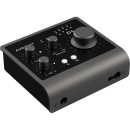
Audient iD4 MKII |
VS | ||||||||
|---|---|---|---|---|---|---|---|---|---|
| Analog: 2 Inputs / 2 Outputs at 96 kHz |
Channels of I/O |
Analog: 2 Inputs / 2 Outputs at 192 kHz |
1 Input / 2 Output |
Analog: 2 Inputs / 6 Outputs at 96 kHz Digital: 8 Input / 0 Output at 48 kHz |
Analog: 2 Inputs / 2 Outputs at 96 kHz |
Analog: 2 Inputs / 2 Outputs at 192 kHz |
Analog: 2 Inputs / 2 Outputs |
Analog: 2 Inputs / 2 Outputs |
Analog: 1 Input / 2 Outputs |
| 96 kHz / 24-Bit | Maximum Sampling Rate | 192 kHz / 24-Bit | 96 kHz / 24-Bit | 96 kHz / 24-Bit | 96 kHz / 24-Bit | 192 kHz / 24-Bit | 192 kHz / 24-Bit | 192 kHz / 24-Bit | 192 kHz / 24-Bit |
| 1 Preamp | Number of Microphone Inputs | 1 | 1 | 2 Preamps | 2 Preamps | 2 | 2 Preamps | 2 Preamps | 1 Preamp |
| 1x Combo XLR-1/4" TRS Balanced Mic/Line Input 1x 1/4" TRS Unbalanced Hi-Z Input (Front Panel) 2x 1/4" TRS Balanced Monitor Output 1x 1/4" TRS Unbalanced Headphone Output (Front Panel) 1x 1/8" / 3.5 mm TRS Unbalanced Headphone Output (Front Panel) |
Analog Audio I/O |
1x XLR 3-Pin Balanced Mic Input 1x 1/4" TS Unbalanced Line/Hi-Z Input (Front Panel) 2x 1/4" TRS Balanced Monitor Output 1x 1/4" TRS Headphone Output (Front Panel) |
1x Combo XLR-1/4" TRS Mic/Line Input 2x 1/4" TRS Balanced Line Output 1x 1/4" TRS Headphone Output |
2x Combo XLR-1/4" TRS Balanced Mic/Line Input 1x 1/4" TRS Unbalanced Hi-Z Input (Front Panel) 4x 1/4" TRS Balanced Line/Monitor Output 1x 1/4" TRS Unbalanced Headphone Output (Front Panel) 1x 1/8" / 3.5 mm TRS Unbalanced Headphone Output (Front Panel) |
2x Combo XLR-1/4" TRS Balanced Mic/Line Input 1x 1/4" TS Unbalanced Hi-Z Input 2x 1/4" TRS Balanced Monitor Output 1x 1/4" TRS Unbalanced Headphone Output |
2x XLR 3-Pin Balanced Mic Input 2x 1/4" TRS Balanced/Unbalanced Line/Hi-Z Input (Front Panel) 2x 1/4" TRS Balanced Monitor Output 1x 1/4" TRS Headphone Output (Front Panel) |
2x Combo XLR-1/4" TRS Balanced/Unbalanced Mic/Line/Hi-Z Input 1x 1/4" TRS Unbalanced Headphone Output 2x 1/4" TRS Balanced Line Output (DC-Coupled) 2x RCA TS Unbalanced Line Output |
2x Combo XLR-1/4" TRS Balanced/Unbalanced Mic/Line/Hi-Z Input (Front Panel) 2x 1/4" TRS Balanced Line Output 1x 1/4" TRS Unbalanced Headphone Output (Front Panel) |
1x Combo XLR-1/4" TRS Balanced/Unbalanced Mic/Line/Hi-Z Input (Front Panel) 2x 1/4" TRS Balanced Line Output 1x 1/4" TRS Unbalanced Headphone Output (Front Panel) |
| 1x USB-C | Host Connection | 1x USB-C | USB-C | 1x USB-C | 1x USB-C | 1x USB-C | 1x USB-C | 1x USB-C | 1x USB-C |
| macOS 10.11.6 or Later macOS 11.1 or Later Windows 7 or Later 6 or Later iPadOS |
OS Compatibility |
macOS Windows |
macOS 10.10 or Later Windows 7 or Later |
macOS 10.11.6 or Later macOS 11.1 or Later Windows 7 or Later |
macOS 10.7.5 or Later Windows 7 or Later (32-/64-Bit) 6 or Later |
macOS Windows |
macOS 10.11 or Later Windows 7 or Later 9 or Later |
macOS Windows |
macOS Windows |
| USB Bus Power | Power Requirements | USB Bus Power, USB Power Adapter (Not Included) | USB Bus Power | USB Bus Power | USB Bus Power | USB Bus Power, USB Power Adapter (Not Included) | USB Bus Power | USB Bus Power | USB Bus Power |
